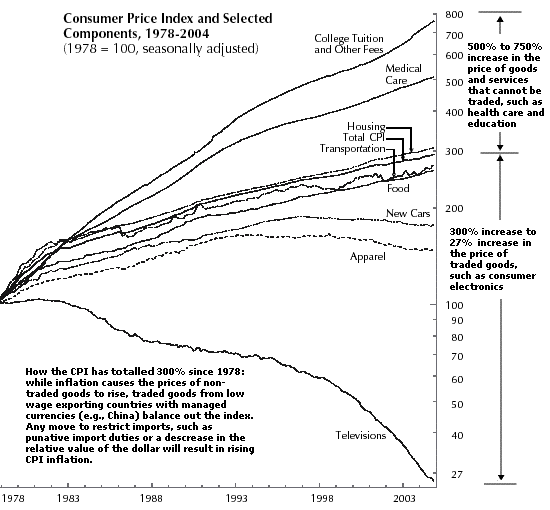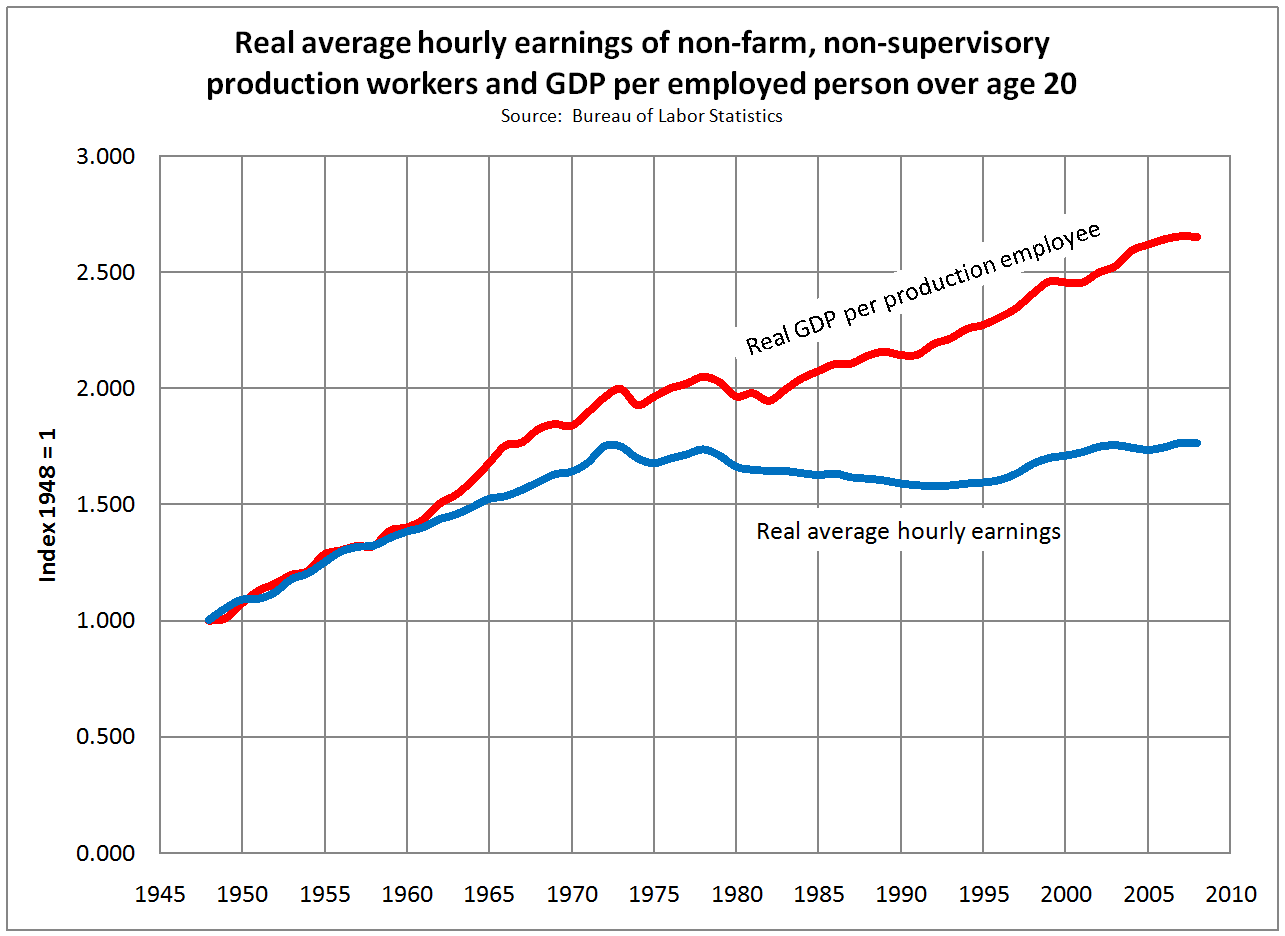Early this morning I read a series of articles1 which expanded on my uneasy expectations of where the US economy is headed, and inspired me to consider what may be done to remedy the situation. The major themes of the posts can be broken down into a few significant areas.
What's broken
- Divergence of GDP growth and Service Industry productivity:

Our socio-economic system is experiencing a growing disparity between GDP and service industries, which is a product of the fixed hourly cost of public services versus the exponential growth of product based markets. The phenomenon is labeled Baumol's cost diease:</p>In a range of businesses, such as the car manufacturing sector and the retail sector, workers are continually getting more productive due to technological innovations to their tools and equipment. In contrast, in some labor-intensive sectors that rely heavily on human interaction or activities, such as nursing, education, or the performing arts there is little or no growth in productivity over time. As with the string quartet example, it takes nurses the same amount of time to change a bandage, or college professors the same amount of time to mark an essay, in 2006 as it did in 1966.
Baumol's cost disease is often used to describe the lack of growth in productivity in public services such as public hospitals and state colleges. Since many public administration activities are heavily labor-intensive there is little growth in productivity over time because productivity gains come essentially from a better capital technology. As a result growth in the GDP will generate little more resources to be spent in public sector. Thus public sector production is more dependent on taxation level than growth in the GDP. (source)
- Ballooning Government Spending:
It seems abundantly clear that the cost structure of the U.S. economy has ballooned to unsustainable levels. By cost structure I mean all the fundamental inputs: energy, healthcare, etc.
For instance: the budget of every city, every county, every agency and every department of every government in the U.S. is under pressure from two basic sources: pension costs and the inexorable rise in mandated healthcare employee costs. What was once a relatively modest share of total employee compensation--healthcare insurance, drug coverage, and eye care--has swollen into a huge percentage of total employee compensation.
If you wonder why building permits now cost more, and parking tickets have tripled, and why garbage fees are skyrocketed, look no further than the crushing burden of ever-rising pension and healthcare costs on every level of government.
These skyrocketing costs act as a huge economy-wide tax, raising the input costs of every good and service in every nook and cranny of the economy. Healthcare (what I call "sick-care" because our collective health continues to slide despite ever-larger sums spent on "curing" us) consumes $2.7 trillion of the $14 trillion U.S. economy--almost 20%. That's equivalent to a 20% VAT (value-added tax) on every purchase.
The bubble mentality of the past decade has also constructed an economy-wide tax. Here is an example. A famed local independent bookstore which once had 3 outlets in the SF Bay Area recently closed its last store. The local newspaper reported it owed two months rent of about $6,600.
How many books would the store have to sell to net $3,300 for basic rent? Add in utlities, employee wages and benefits, cash flow needed to maintain inventory, etc. and you come up with a stupendous number of books which would have to be sold.
Compare that to a cost structure in which rent was $500 per month.
(source) - Government is incapable of simplifying: Our national government is incapable of simplifying, improving public service efficiency, or rational cost cutting in areas which have grown without check.
Bureaucracies and institutions may suffer from Baumol's Disease, but they also suffer from the Ratchet Effect: they only know how to add expenses and scale up. Productivity, Baumol's Disease and the Cliff Just Ahead (December 8, 2010) Baumol's Disease describes the rising costs of sectors whose productivity gains lag behind more productive sectors. Thus education costs more even as manufactured goods fall in price, as labor-intensive education doesn't lend itself to leaps in productivity.
But Baumol's Disease doesn't explain why fighter aircraft now cost $300 million each when the "best of the best" five years ago cost $56 million, or how Medicare has leaped from $52 billion a year to $600 billion a year in a decade. Nor does it explain why property taxes have risen 60% above inflation in the past 10 years.
What does explain these gigantic increases is monopoly powers granted to cartels by unaccountable State fiefdoms. With the Federal government able to borrow and spend without any visible limits, then the sky's the limit on everything from MRI tests to Medicaid to foreign wars. With the public unable to opt out of local government, then local government expands and passes the costs onto the private-sector tax donkeys. (source)
- Real wages are contracting: The purchasing power of an average American is dropping while at the same time our nations overall productivity (GDP) is growing. Where's the additional revenue going? The solution is that wealth is compressing into the hands of fewer people, yielding flat averages but overall GDP growth.

What can be done to remedy the situation
When large complex systems such as our economy become broken, there are two broad strategies for remedying the situation.
- Adapt laws to patch it: The first strategy is to make subtle changes in law which promote natural competition which distributes the problem. For software developers this is the equivalent of patching bugs in a library. The only limitation of legal patches is that they are unable to fix fundamental flaws in design without a complete overhaul
- Adopt alternative systems: Another method to repair our economy is to adopt a brand new economic system. We could reinvent capitalism, with an understanding of it's connection to public services. A variety of different socio-economic systems could compete in parallel on small scales, as they do in our states and counties, allowing us to identify which best works for our federal government. There's no reason for a drastic shift, merely allowing the existence of alternatives is enough to propel our nation down a path of parallel economic evolution. Folks will self select the systems which best serve their needs. Imagine the possibility of dynamic socio-economic systems.
- The Devolution of the Consumer Economy, Part II: Rising Costs, Declining Wages
- Lowering the Cost Structure of the U.S. Economy
- Productivity, Baumol's Disease and the Cliff Just Ahead and Baumol's cost disease
- Who will demand reductions in public employee benefits?
- Bureau of Labor Statistics, all types of charts can be created on the data page